Guppies are a popular choice among freshwater aquarium enthusiasts, and it’s easy to see why – their stunning appearance never fails to captivate.
Now, let’s chat about tank mates: which fish can happily coexist with guppies? It’s essential to know who makes good friends and who to be cautious of.
I’ve gathered plenty of insights through years of trial and error. In this article, I’ll be sharing my experiences with you, covering both the upsides and the hurdles.
So, without any more delay, let’s dive right in.

How To Pick Tank Mates for Guppy Fish
Picking tank mates for guppy fish is about ensuring compatibility and creating a harmonious aquarium environment.
It’s important to consider factors like size, temperament, water parameters, and dietary needs of both guppies and their potential tank mates.
- Size Compatibility: Choose fish that are similar in size to guppies, ideally not larger than 2-3 inches. Large or aggressive fish might see guppies as prey, leading to stress or injury.
- Temperament Match: Opt for peaceful, non-aggressive species. Aggressive or territorial fish can harass guppies, causing stress and potential harm to these peaceful swimmers.
- Water Parameter Alignment: Ensure that potential tank mates thrive in the same water conditions as guppies – pH levels around 7.0-7.2, and temperatures between 72°F to 82°F.
- Dietary Considerations: Select species with similar dietary requirements. Guppies are omnivores that enjoy a varied diet, so avoid fish requiring specialized diets that could complicate feeding routines.
- Activity Level Sync: Look for fish with a similar activity level. Too active or too passive species can disrupt the guppies’ natural behavior, affecting their health and well-being.
21 Best Tank Mates for Guppies
Considering the factors above, let’s delve into the best companions to keep with guppies in their tank:
| Species | Compatibility Score with Guppies |
| Neon Tetra | 10 |
| Corydoras Catfish | 10 |
| Platies | 9 |
| Mollies | 9 |
| Harlequin Rasboras | 9 |
| Dwarf Gourami | 8 |
| Zebra Danios | 8 |
| Cherry Shrimp | 8 |
| Otocinclus Catfish | 8 |
| Bristlenose Pleco | 7 |
| Ghost Shrimp | 7 |
| Amano Shrimp | 7 |
| Swordtails | 7 |
| Cardinal Tetra | 7 |
| Snails (like Nerite and Mystery) | 6 |
| Endler’s Livebearer | 6 |
| Honey Gourami | 6 |
| Rummy-Nose Tetra | 5 |
| Siamese Algae Eater | 5 |
| Ember Tetra | 5 |
| Kuhli Loach | 5 |
Also Read: Guppy Care Guide
1. Neon Tetra

- Scientific Name: Paracheirodon innesi
- Temperature: 70-81°F (21-27°C)
- pH: 6.0-7.0
- Minimum Tank Size: 10 gallons
- Adult Size: Up to 1.5 inches
- Recommended School Size: 6 or more
- Care Level: Easy
- Compatibility with Guppies: 10/10
Neon Tetras are a great choice to pair with guppies.
They’re both peaceful and prefer similar water parameters, like a pH around 7 and temperatures between 72 to 78 degrees Fahrenheit.
Neon Tetras tend to stick to the middle layers of the tank, which works well since guppies often swim in the upper layers.
Plus, their bright blue and red stripes add a fantastic splash of color, complementing the guppies’ vibrant hues without causing any competition for attention.
Also Read: Can Neon Tetras And Guppies Live Together?
2. Corydoras Catfish
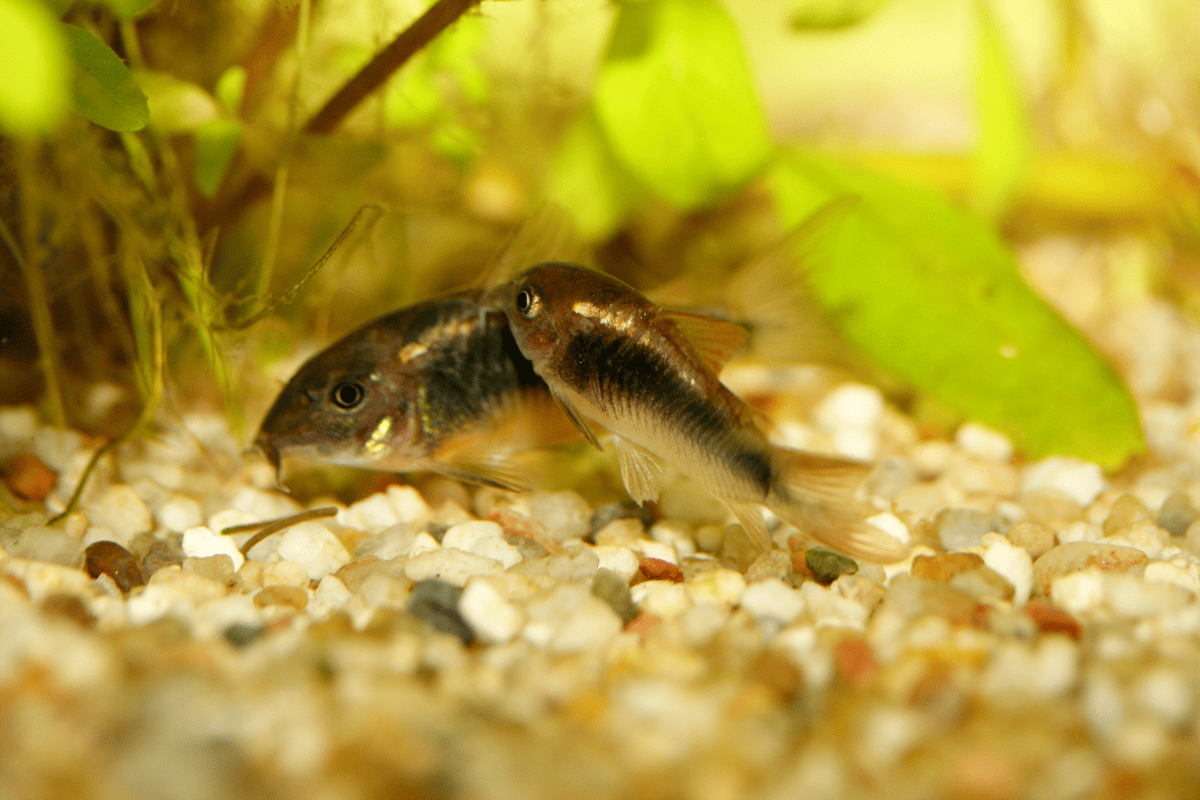
- Scientific Name: Corydoras spp.
- Temperature: 72-78°F (22-26°C)
- pH: 7.0-7.8
- Minimum Tank Size: 20 gallons
- Adult Size: 1-4 inches, depending on species
- Recommended School Size: 6 or more
- Care Level: Easy
- Compatibility with Guppies: 10/10
Corydoras are fantastic tank mates for guppies. They’re bottom dwellers, so they occupy a different space in the aquarium, reducing territorial disputes.
These catfish are peaceful, easygoing, and they do a great job keeping the tank clean by scavenging leftovers. Just ensure the substrate is soft to protect their delicate barbels!
Also Read: Cory Catfish And Guppies
3. Platies

- Scientific Name: Xiphophorus maculatus
- Temperature: 72-78°F (22-26°C)
- pH: 7.0-8.3
- Minimum Tank Size: 10 gallons
- Adult Size: Up to 2.5 inches
- Recommended School Size: 3-4 or more
- Care Level: Easy
- Compatibility with Guppies: 9/10
Platies are a no-brainer when it comes to companion species for guppies. They share a similar disposition – peaceful, active, and playful.
Their tolerance for a wide range of water conditions makes them adaptable to environments that suit guppies.
Plus, they come in various colors and patterns, creating a visually dynamic aquarium.
4. Mollies

- Scientific Name: Poecilia spp.
- Temperature: 72-78°F (22-26°C)
- pH: 7.5-8.5
- Minimum Tank Size: 20 gallons
- Adult Size: Up to 4.5 inches
- Recommended School Size: 4 or more
- Care Level: Moderate
- Compatibility with Guppies: 9/10
Mollies are like the larger cousins of guppies and they get along famously. They’re both livebearers and share similar breeding behaviors, which can be fascinating to observe.
Mollies are adaptable to different water conditions, though they do appreciate a bit of salinity, something guppies can tolerate as well.
Just watch out for the size difference; larger mollies might bully smaller guppies if not monitored.
Also Read: Can Molly Fish And Guppies Live Together?
5. Harlequin Rasboras
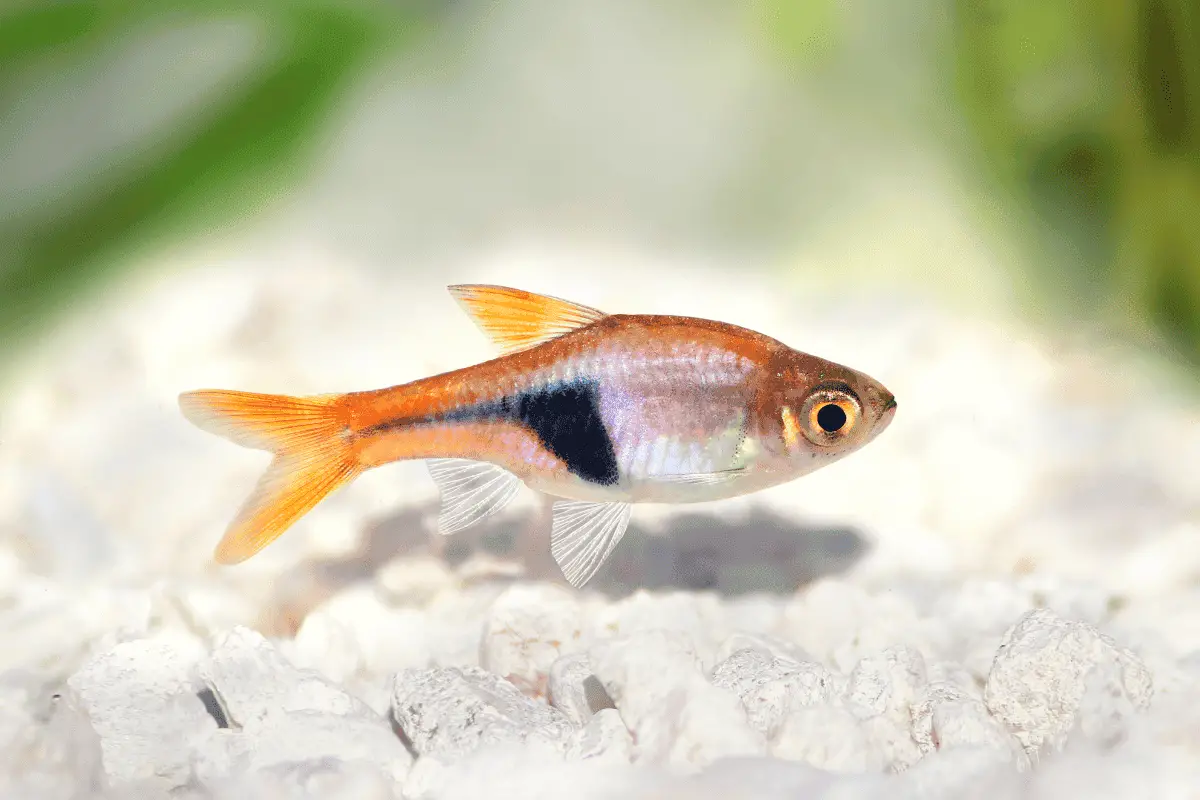
- Scientific Name: Trigonostigma heteromorpha
- Temperature: 72-82°F (22-28°C)
- pH: 6.0-7.5
- Minimum Tank Size: 10 gallons
- Adult Size: Up to 2 inches
- Recommended School Size: 6 or more
- Care Level: Easy
- Compatibility with Guppies: 9/10
These are some of the most serene fish you can pair with guppies.
Harlequin Rasboras are known for their peaceful demeanor and striking appearance, with their unique triangular pattern.
They require similar water conditions as guppies, making tank maintenance a breeze. Their schooling nature provides a calming effect and a beautiful, synchronized swimming display.
6. Dwarf Gourami

- Scientific Name: Trichogaster lalius
- Temperature: 77-82°F (25-28°C)
- pH: 6.0-7.5
- Minimum Tank Size: 10 gallons
- Adult Size: Up to 3.5 inches
- Recommended School Size: 1-2 (Preferably solo or in a pair)
- Care Level: Moderate
- Compatibility with Guppies: 8/10
Dwarf Gouramis can be a bit tricky but can coexist well with guppies if conditions are right. They prefer a planted tank, which also benefits guppies by providing hiding spaces.
It’s important to monitor their interaction, though, as gouramis can sometimes be territorial. Providing ample space and hiding spots can mitigate any potential issues.
7. Zebra Danios

- Scientific Name: Danio rerio
- Temperature: 64-75°F (18-24°C)
- pH: 6.5-7.2
- Minimum Tank Size: 10 gallons
- Adult Size: Up to 2.5 inches
- Recommended School Size: 6 or more
- Care Level: Easy
- Compatibility with Guppies: 8/10
Zebra Danios are a lively bunch and can keep up with the energy of guppies. They’re hardy fish, tolerating a wide range of water conditions, just like guppies.
They prefer to swim in groups, adding a dynamic energy to the tank. Just ensure the tank is spacious enough, as danios are quite active and need room to swim.
8. Cherry Shrimp

- Scientific Name: Neocaridina davidi
- Temperature: 65-80°F (18-27°C)
- pH: 6.5-8.0
- Minimum Tank Size: 5 gallons
- Adult Size: Up to 1.5 inches
- Recommended School Size: 5 or more (thrives in groups)
- Care Level: Easy
- Compatibility with Guppies: 8/10
Cherry Shrimp are a fantastic choice for a guppy tank.
They’re incredibly peaceful and spend most of their time scavenging for algae and leftover food, which helps keep the tank clean.
Since they’re small and non-invasive, they won’t bother your guppies. Just ensure there are plenty of hiding spots like plants or driftwood, as Cherry Shrimp can be vulnerable when molting.
9. Otocinclus Catfish

- Scientific Name: Otocinclus spp.
- Temperature: 72-79°F (22-26°C)
- pH: 6.5-7.5
- Minimum Tank Size: 10 gallons
- Adult Size: Up to 2 inches
- Recommended School Size: 6 or more (prefers being in a group)
- Care Level: Moderate
- Compatibility with Guppies: 8/10
Otos are great companions for guppies. They’re peaceful, small, and primarily focused on algae eating, which means they contribute to maintaining a clean tank.
They thrive in the same water conditions as guppies and are known for being non-aggressive.
Just be sure to supplement their diet with algae wafers if there isn’t enough natural algae growth in the tank.
10. Cardinal Tetra

- Scientific Name: Paracheirodon axelrodi
- Temperature: 73-81°F (23-27°C)
- pH: 4.5-7.0
- Minimum Tank Size: 10 gallons
- Adult Size: Up to 2 inches
- Recommended School Size: 6 or more
- Care Level: Moderate
- Compatibility with Guppies: 7/10
Cardinal Tetras are another excellent match. Like Neon Tetras, they prefer similar water conditions as guppies and are also peaceful.
They’re a bit more vibrant than Neons, with their bright red and blue striping extending the length of their bodies.
They tend to stay in the mid to lower levels of the tank, complementing the guppies’ preference for the upper layers.
11. Amano Shrimp

- Scientific Name: Caridina multidentata
- Temperature: 70-78°F (21-26°C)
- pH: 6.0-7.5
- Minimum Tank Size: 10 gallons
- Adult Size: Up to 2 inches
- Recommended School Size: 3 or more
- Care Level: Easy
- Compatibility with Guppies: 7/10
Amano Shrimp are larger and more robust than Cherry Shrimp, making them less likely to be bothered by guppies.
They’re exceptional algae eaters and can help keep the tank environment clean.
They’re peaceful and tend to mind their own business, but do ensure they have enough space and hiding places, especially during their molting phase.
12. Swordtails

- Scientific Name: Xiphophorus hellerii
- Temperature: 72-79°F (22-26°C)
- pH: 7.0-8.3
- Minimum Tank Size: 15 gallons
- Adult Size: Up to 5 inches
- Recommended School Size: 3-4 or more
- Care Level: Easy
- Compatibility with Guppies: 7/10
Swordtails are a natural fit with guppies. They’re both livebearers and share many of the same water requirements.
Swordtails are generally peaceful, but they can grow larger than guppies, so it’s important to provide enough space to prevent any possible bullying.
Their variety of colors and the males’ distinctive sword-like tails add a unique aesthetic to the tank.
13. Bristlenose Pleco
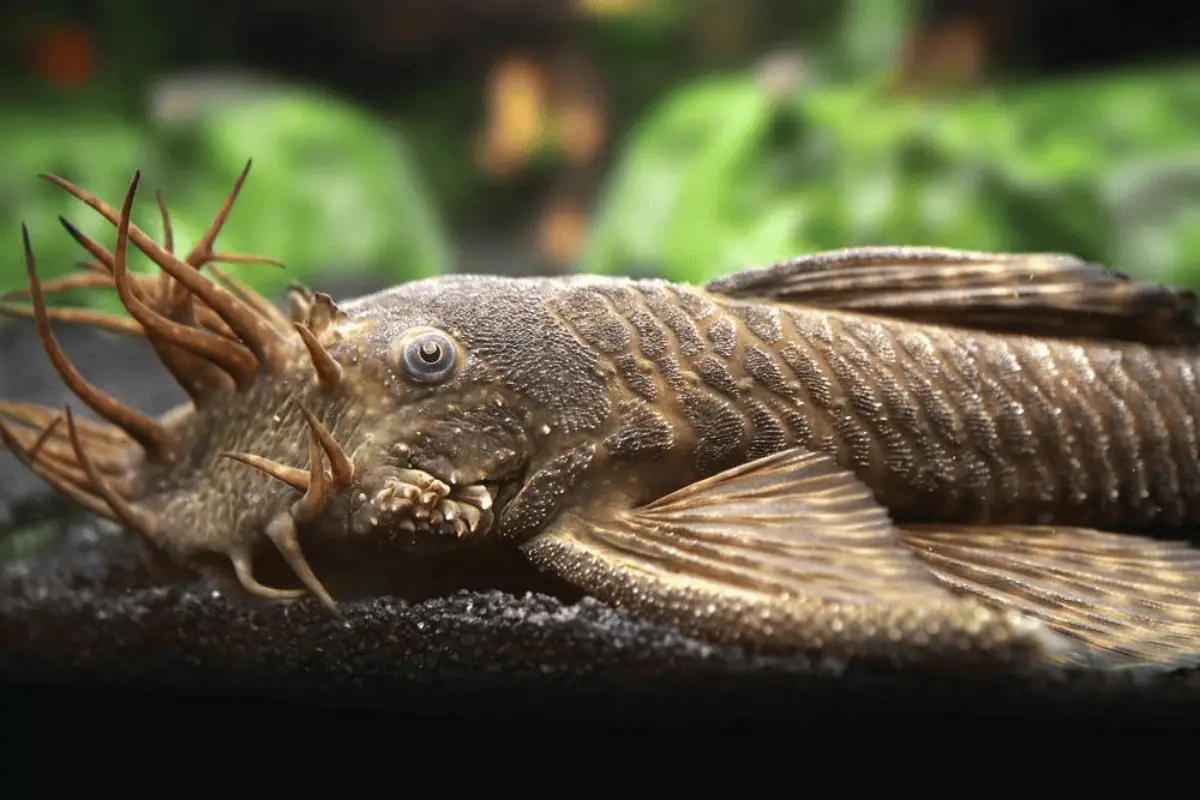
- Scientific Name: Ancistrus spp.
- Temperature: 73-81°F (23-27°C)
- pH: 6.5-7.5
- Minimum Tank Size: 20 gallons
- Adult Size: Up to 6 inches
- Recommended School Size: Solo or in pairs
- Care Level: Easy
- Compatibility with Guppies: 7/10
Bristlenose Plecos are one of the best pleco species to pair with guppies.
They’re peaceful and spend most of their time suctioned to the tank glass or decorations, eating algae.
They grow to a size that’s manageable for a community tank. Just make sure your tank is large enough (at least 20 gallons) as they can grow up to 5 inches.
Also Read: Can Guppies Live With Plecos?
14. Ghost Shrimp

- Scientific Name: Palaemonetes paludosus
- Temperature: 65-82°F (18-28°C)
- pH: 7.0-8.0
- Minimum Tank Size: 5 gallons
- Adult Size: Up to 1.5 inches
- Recommended School Size: 5 or more
- Care Level: Easy
- Compatibility with Guppies: 7/10
Ghost Shrimp are similar to Cherry and Amano Shrimp in their peaceful nature and scavenging habits. They’re almost transparent, which can be quite intriguing to watch.
They’re good at cleaning up leftover food and algae, but they’re delicate, so ensure there are hiding places for them.
They’re generally safe with guppies, but like other shrimp, they can be vulnerable when molting.
15. Snails

- Temperature: 68-82°F (20-28°C)
- pH: 6.5-8.2
- Minimum Tank Size: 5 gallons
- Recommended School Size: Solo or small groups
- Care Level: Easy
- Compatibility with Guppies: 6/10
Snails such as Nerite and Mystery are excellent tank mates for guppies.
They play a crucial role in algae control and cleaning up leftover food, helping to maintain a healthy aquarium environment.
They are non-aggressive and have no interest in bothering fish, making them ideal for a peaceful community tank.
Just keep an eye on water quality, as overfeeding can lead to excessive snail population growth.
16. Endler’s Livebearer

- Scientific Name: Poecilia wingei
- Temperature: 72-82°F (22-28°C)
- pH: 7.0-8.0
- Minimum Tank Size: 10 gallons
- Adult Size: Up to 1.8 inches
- Recommended School Size: 3-4 or more (prefers living in small groups)
- Care Level: Easy
- Compatibility with Guppies: 6/10
Endler’s Livebearers are closely related to guppies and get along with them splendidly. They share many of the same water parameter needs and breeding behaviors.
Their small size and peaceful nature make them a perfect match. The vibrant colors and patterns of Endler’s can complement those of guppies, creating a visually stunning display.
17. Honey Gourami

- Scientific Name: Trichogaster chuna
- Temperature: 71-82°F (22-28°C)
- pH: 6.0-7.5
- Minimum Tank Size: 10 gallons
- Adult Size: Up to 2 inches
- Recommended School Size: 1-2 (can be kept solo or in pairs)
- Care Level: Moderate
- Compatibility with Guppies: 6/10
Honey Gouramis are a great choice for a community tank with guppies. They are among the more peaceful gourami species and generally do not bother other fish.
They prefer a planted tank with plenty of hiding spots, which also suits guppies. It’s important to provide enough space to prevent any territorial behavior from the gouramis.
18. Rummy-Nose Tetra

- Scientific Name: Hemigrammus rhodostomus
- Temperature: 72-80°F (22-27°C)
- pH: 5.5-7.0
- Minimum Tank Size: 20 gallons
- Adult Size: Up to 2.5 inches
- Recommended School Size: 6 or more
- Care Level: Moderate
- Compatibility with Guppies: 5/10
Rummy-Nose Tetras are known for their distinctive red noses and are a great addition to a guppy tank.
They are peaceful and prefer to school together, which can provide a nice dynamic to the aquarium.
They thrive in similar water conditions as guppies and are generally non-aggressive. Their schooling behavior and contrasting colors can create a beautiful, active display.
19. Siamese Algae Eater

- Scientific Name: Crossocheilus oblongus
- Temperature: 75-79°F (24-26°C)
- pH: 6.5-7.0
- Minimum Tank Size: 20 gallons
- Adult Size: Up to 6 inches
- Recommended School Size: Solo or in small groups
- Care Level: Moderate
- Compatibility with Guppies: 5/10
Siamese Algae Eaters are beneficial for their algae-eating habits, helping to keep the tank clean. They are generally peaceful and can coexist well with guppies.
However, they can grow relatively large (up to 6 inches), so they require a larger tank.
It’s also important to supplement their diet with algae wafers or vegetables if there’s not enough algae.
20. Ember Tetra

- Scientific Name: Hyphessobrycon amandae
- Temperature: 73-84°F (23-29°C)
- pH: 5.5-7.0
- Minimum Tank Size: 10 gallons
- Adult Size: Up to 1 inch
- Recommended School Size: 6 or more
- Care Level: Easy
- Compatibility with Guppies: 5/10
Ember Tetras are small, peaceful fish that make excellent companions for guppies. They prefer similar water conditions and are known for their bright, fiery orange coloration.
Their small size and peaceful nature mean they won’t bother guppies, and they add a beautiful splash of color to the tank.
21. Kuhli Loach

- Scientific Name: Pangio kuhlii
- Temperature: 75-86°F (24-30°C)
- pH: 5.5-7.0
- Minimum Tank Size: 20 gallons
- Adult Size: Up to 4 inches
- Recommended School Size: 5 or more (prefers being in a group)
- Care Level: Moderate
- Compatibility with Guppies: 5/10
Kuhli Loaches are unique and fascinating fish that can be a great addition to a guppy tank.
They are nocturnal and spend most of their time hiding during the day, so they rarely interact with guppies.
They’re peaceful and do well in a tank with plenty of hiding spots. Just ensure the substrate is soft to protect their delicate bodies.
Species to Avoid in a Guppy Fish Tank
Not all fish species are compatible as tank mates for guppies. When creating a new aquarium, here are some creatures you should avoid:
1. African Cichlids

These are generally not a good match for guppies due to their aggressive and territorial nature.
They can become quite large and tend to dominate smaller, more peaceful fish like guppies.
Additionally, African Cichlids require different water parameters, preferring higher pH and harder water, which is not ideal for guppies.
The combination of differing water requirements and their aggressive behavior makes them unsuitable tank mates for guppies.
2. Oscar Fish

Oscars are known for their aggressive and predatory nature, making them poor companions for guppies.
They grow to a significant size and can easily view smaller fish like guppies as food.
Oscars also require larger aquariums and different environmental conditions compared to guppies.
Their size and temperament make them a risky choice for a community tank with guppies.
3. Red Tailed Shark
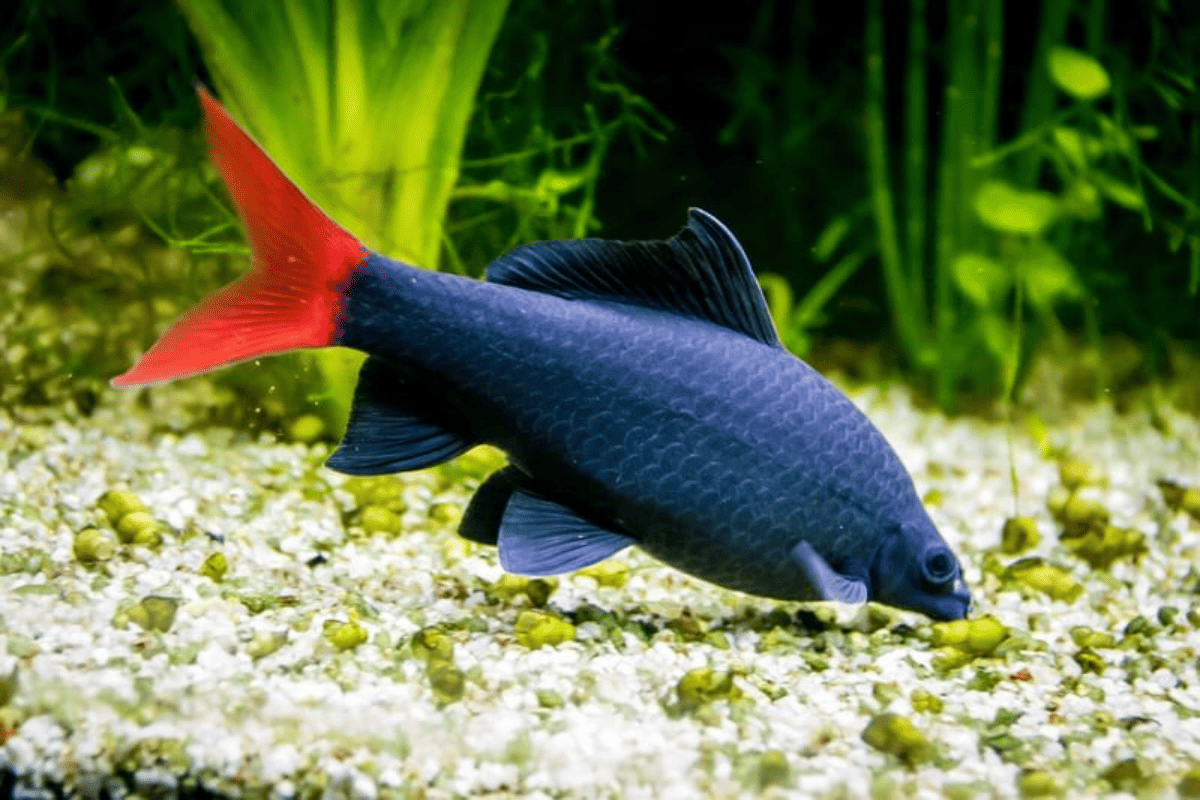
Red Tailed Sharks can be territorial and may become aggressive, especially in smaller tanks.
They often claim a territory in the aquarium and can be aggressive towards fish that enter this space, including guppies.
While they are not large predators, their territorial behavior can stress and harm guppies.
The risk of aggression increases as the Red Tailed Shark matures, making it an unsuitable companion for guppies.
4. Betta Fish (Siamese Fighting Fish)

Bettas are known for their territorial and aggressive behavior, especially males. They can become aggressive towards guppies, mistaking their colorful tails for rival bettas.
Bettas also prefer calmer waters, whereas guppies are more active swimmers, which can lead to stress for both species.
The risk of aggression and differing preferences in tank environment make bettas a poor choice for housing with guppies.
5. Jack Dempsey

Jack Dempseys are large, territorial, and can be quite aggressive, making them unsuitable for a community tank with guppies.
They require larger tanks and more robust filtration systems compared to what guppies need. Their aggressive nature can pose a significant threat to the safety of guppies.
Additionally, Jack Dempseys have different dietary requirements and water parameters, further complicating their compatibility with guppies.
6. Arowana

Arowanas are large predatory fish and are not suitable for a community tank with small, peaceful fish like guppies.
They can grow to an impressive size, requiring much larger tanks than what guppies need.
Arowanas are known to eat smaller fish, and guppies would likely be seen as prey. The size difference and predatory nature of Arowanas make them incompatible with guppies.
10. Plecostomus (Common Pleco)
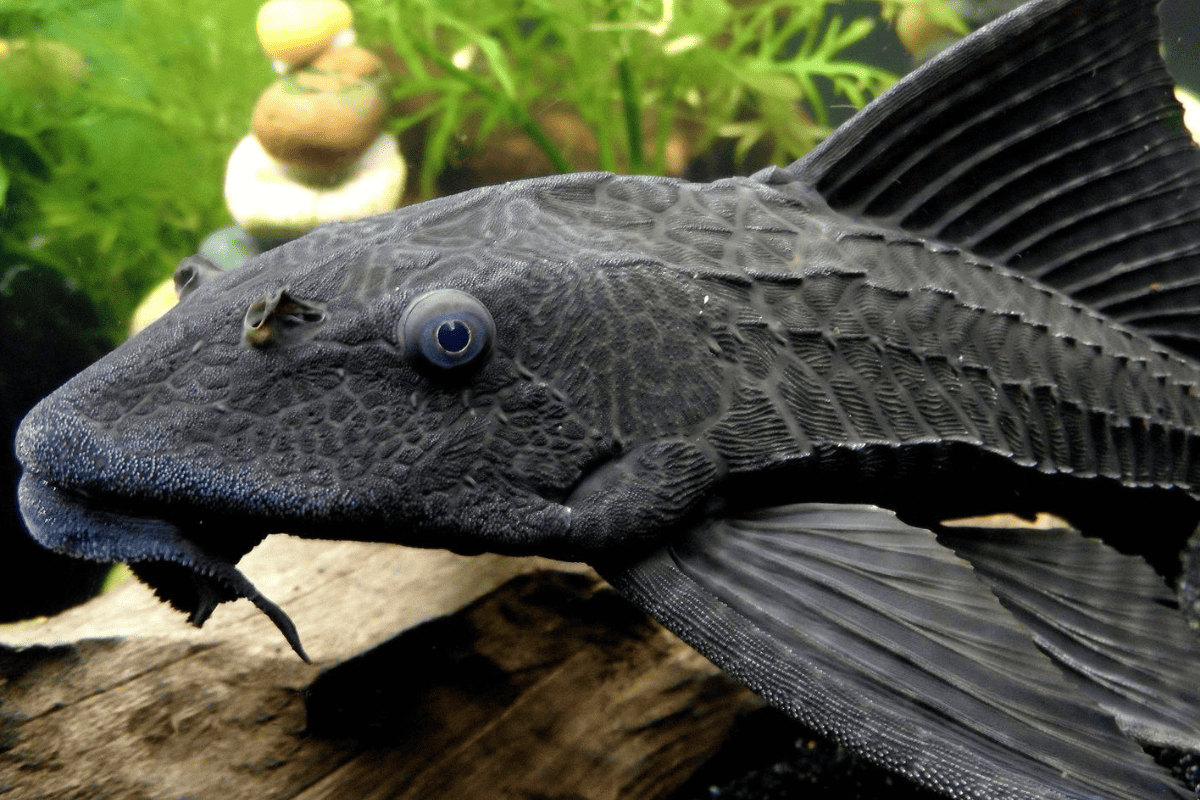
While young Plecostomus may seem harmless, they grow very large and can become territorial.
Their size can be intimidating for guppies, and in confined spaces, plecos can accidentally harm smaller fish.
They also require different environmental conditions and more space as they grow.
The significant size difference and potential for territorial behavior make common plecos a poor choice for a guppy tank.
11. Discus Fish

Discus fish are not good tank mates for guppies.
They require very specific water conditions (pH 6.0-7.0, temperature 82-88°F) that are quite different from what guppies need, and they also need a much calmer environment.
Additionally, their large adult size (up to 8 inches) and need for a larger tank (minimum 50 gallons) make them incompatible with the smaller and more active guppies.
Also Read: Guppies And Discus Fish
12. Clown Loaches

Clown loaches are also not ideal tank mates for guppies.
They can grow quite large (up to 12 inches), requiring a much larger tank (minimum 100 gallons), and their active and sometimes boisterous behavior can be stressful for guppies.
Furthermore, their preference for slightly softer and more acidic water conditions (pH 6.0-7.5, temperature 75-85°F) differs from that of guppies.
Also Read: Can Guppies Live With Clown Loaches?
13. Angelfish

Angelfish have a tendency to be territorial and can become aggressive, especially during breeding, which can pose a threat to smaller and more peaceful fish like guppies.
Also, angelfish require larger tanks (minimum 30 gallons) due to their size (up to 6 inches) and need for swimming space, and their water parameters (pH 6.5-7.5, temperature 76-82°F) are not fully aligned with guppy requirements.
Also Read: Can Angelfish And Guppies Live Together?
Tips for Keeping Guppies in Community Tanks
To successfully keep guppies in a community tank, focus on creating a balanced, stress-free environment for them.
It’s important to choose compatible tank mates and maintain ideal water conditions for their well-being.
- Choose Compatible Tank Mates: Opt for calm species like Corydoras Catfish or Harlequin Rasboras; avoid aggressive fish such as Oscars or Jack Dempseys that can stress or harm guppies.
- Monitor Water Parameters: Keep the water at a pH of 6.8-7.8 and temperature between 72-82°F; use a reliable aquarium test kit weekly to ensure stable water conditions.
- Provide Adequate Space: Maintain a spacious tank, ideally 2 gallons per guppy, to prevent overcrowding; a 20-gallon tank is a good start for a small group of guppies.
- Offer Varied Diet: Feed guppies high-quality flake food supplemented with frozen or live foods like brine shrimp; ensure a balanced diet for overall health.
- Create Hiding Places: Add plants, rocks, or decorations to provide hiding spots; this helps reduce stress and provides a natural environment for guppies.
- Observe Regularly: Watch for signs of stress or illness, such as faded colors or lethargy; early detection can prevent problems from spreading in the tank.
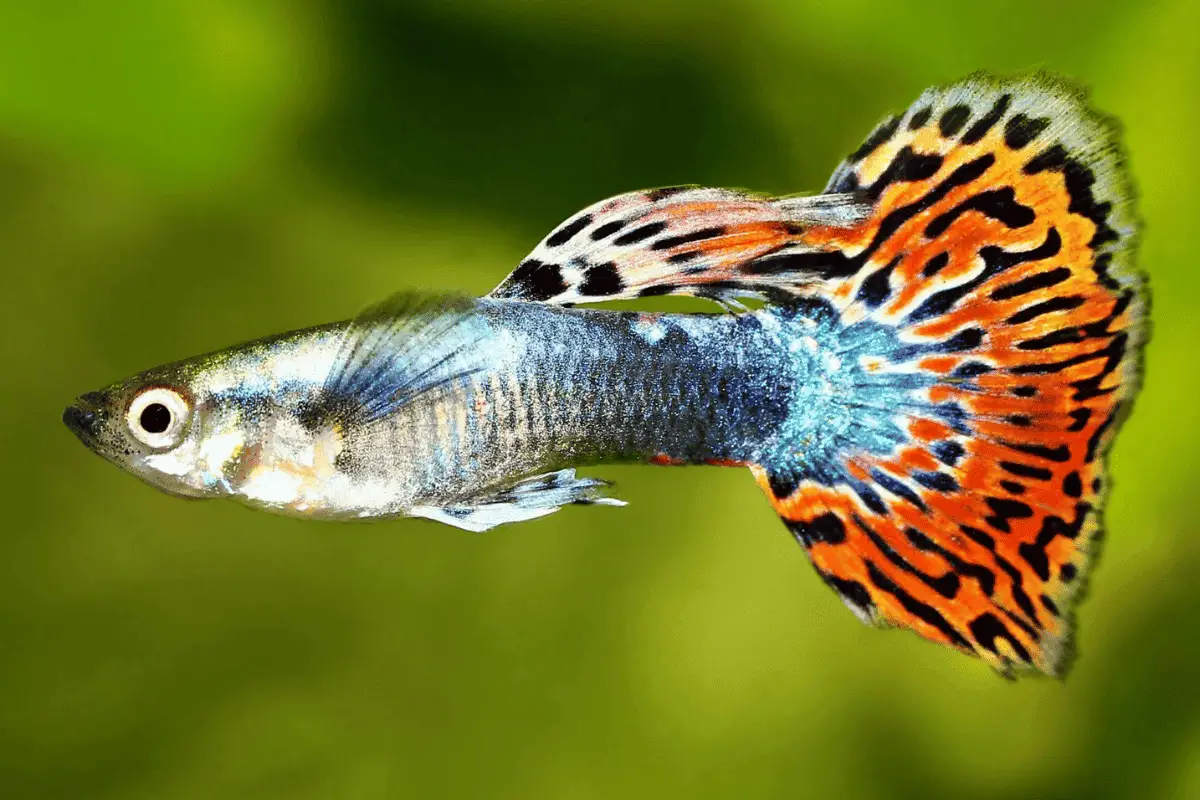
Can Guppies Live in Pairs?
Guppies can live in pairs, but they are social fish that thrive in groups, so a pair might not be ideal for their social needs.
In a pair, the male may continuously chase the female, which can lead to stress for her.
It’s usually better to keep them in larger groups to disperse this behavior and ensure a happier environment.
Also Read: Pregnant Guppy Care
How Many Guppies Should Live Together?
A good rule of thumb is to keep guppies in groups of at least five to ten individuals to satisfy their social nature and prevent stress.
In such groups, it’s ideal to maintain a ratio of about two females to every male to prevent the females from being overly harassed.
The size of the aquarium should also be considered, with a general guideline of at least 2 gallons of water per guppy to provide enough space.

Conclusions
For quick readers, here’s a short summary:
- Selecting tank mates for guppies involves considering size, temperament, water conditions, and diet to ensure a peaceful and healthy aquarium environment.
- Ideal companions include small, non-aggressive fish like Neon Tetras and Corydoras Catfish, which share similar water parameters and dietary needs with guppies.
- Compatibility with guppies is high for peaceful species like Platies and Mollies, who share similar breeding behaviors and adapt well to similar water conditions.
- Species such as African Cichlids, Oscars, and Bettas should be avoided due to their aggressive nature and differing water requirements, posing risks to guppies.
- Successful guppy tank management includes maintaining stable water conditions, providing adequate space and hiding places, and ensuring a balanced diet for all inhabitants.

